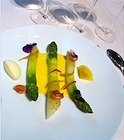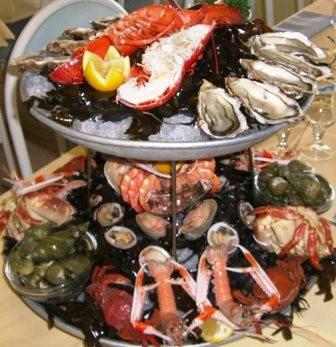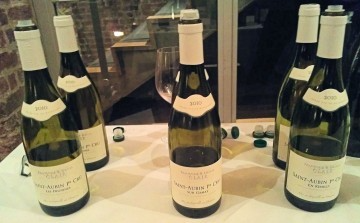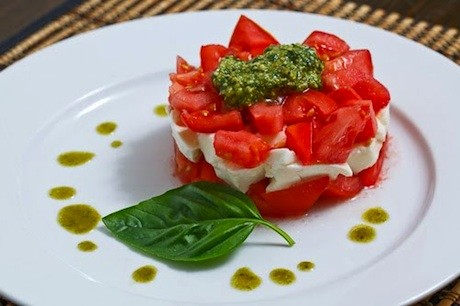Summer Flavors in Paris Restaurants, Part One

Tue 3 Jul 2012
With the change of seasons in the City of Light, there’s also a change of flavors on the menus of Paris restaurants. Here’s a sampling of the ingredients du jour and what you can drink with them at home for your own Parisian feast.
Seafood Platters

Photo: http://lettredeparis.com/2012/01/bonne-annee-2012/.
People tend to eat lighter in warmer temperatures, and beautiful fruits de mer platters are popping up on bistro tables all over town. You’ll often see large double-decker selections on ice with a plethora of prawns, lobster, oysters, langoustine, crab and some local specialties like whelks, cockles and sting winkles. Historic brasserie Bofinger has seafood plates you can order for dining there or to go, and Le Bar à Huîtres serves its multitiered platters with liquid smoke for a grand presentation.
Muscadet, a wine made at the Western edge of the Loire from the grape also known as the melon de Bourgogne, is the perfect summer white, supercrisp and racy and made for seafood platters. Many muscadets benefit from sur lie aging, which gives them another important dimension in terms of the texture and fullness on the palate. Consider Domaine de la Pépière, at $18.
White Fish

Photo: http://elitistreview.com/2012/01/17/2010-burgundy-tasting-with-haynes-hanson-and-clark/.
You’ll see many different types of white fish on the menus now in Paris, with familiar favorites like lotte, or monkfish, and the currently in-season Saint-Pierre, or John Dory. The preparations are lighter, with a delicate butter sauce, or, as at the Belleville institution Le Baratin, the lotte is pan roasted with the Mexican flavors of cumin and cilantro.
Viognier is one of the principal white Rhône grape varieties, and it stands up well to the more exotic flavors of cumin and cilantro. It also pairs well with the naturally sweet, dense quality of the monkfish because of its lower acidity and lush texture. Consider E. Guigal’s Côtes du Rhône Blanc, which is roughly 60 percent viognier, at about $14. Chardonnay has a similarly lush mouthfeel and is a hit with any butter-based sauce. I’d highly recommend the Saint-Aubin from Françoise and Denis Clair for $40.
Asparagus

Photo: http://www.frenchcravings.com/category/paris/paris-eats/.
Lovely green and white stalks of this vegetable, of every thickness, fill the farmers’ markets and bistro menus. L’Atelier in Arles recently served a dish with thin, just cooked asparagus framing the plate and a gently cooked fried egg resting in the middle, with bits of bacon scattered on top. Once the yolk was broken, the flavors mixed seamlessly and deliciously.
Wine with asparagus is a tricky pairing, as the vegetable contains several amino acids that can create unpleasant sulfur and metallic flavors. Bear in mind that when serving asparagus, you basically want to avoid highly tannic and overly oaked wines.
Alsatian pinot gris, with its combination of acidity and heft, will work well with the greener more vegetal flavors of the asparagus but also embrace the salty bacon flavor and cut through the richness of the egg yolk, which can have a cloying effect. Domaine Zind Humbrecht Pinot Gris is available for around $25. I would also recommend a Provençal rosé like MIP (Made in Provence), from Domaine Sainte-Lucie, for about $17.
Fruit
One of my favorite foods to eat in warmer temperatures is just-picked fruit from the fields. Strawberries are taking their final bow, but luckily there’s a whole new gang emerging for the summer, including melons, cantaloupes and apricots. I’ve seen strawberry-watermelon soup with a little mint served at the end of a meal, and at La Maison Jaune in Saint-Rémy, cantaloupe and ice cream are mixed for a refreshing dessert.
Fresh fruit is another challenge for a wine pairing, because it can make a wine taste bitter and thin. I’d go with a crémant de Loire, which is a sparkling wine made from chenin blanc grapes and shows a very pretty honeyed and juicy quality that would be delicious with either of those desserts.
Caprese Salad

Photo: http://www.closetcooking.com/2010/08/diced-caprese-salad.html.
This is a classic on most menus year-round, even when the mozzarella isn’t that good and the tomatoes aren’t in season. There are some good vine-ripened tomatoes floating around, and I recently had a nice preparation at Le Basilic, where the usual staples of fresh basil, a chewy, but not too runny, mozzarella and a sprinkling of woodsy balsamic vinegar were included.
Beware of vinaigrettes: generally the acidity in the food should match the acidity in the wine. A chef suggested that when serving wine with vinaigrette, you should add a bit of the wine into the vinaigrette to ensure that the wine and food are incorporated.
A classic white Bordeaux blend of sémillon and sauvignon blanc will deliver a fruity, herbal and slightly creamy wine that mirrors the qualities of the Caprese salad’s ingredients: fruity tomato, herbal basil and creamy mozzarella. Try Château Graville-Lacoste for about $18.
Related Links/Info
Bofinger
Le Bar à Huîtres
Le Baratin
E. Guigal’s Côtes du Rhône Blanc
L’Atelier
Domaine Zind Humbrecht Pinot Gris
MIP Rosé (Made in Provence), Domaine Sainte-Lucie
La Maison Jaune
Le Basilic
Château Graville-Lacoste
Editor’s note: Have you downloaded any of our Girls’ Guide foodie trips yet? They’re available as pdfs or as apps for your iPhone.